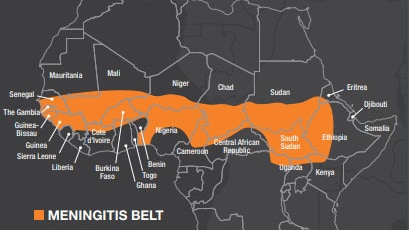Key points
- Meningococcal disease occurs worldwide.
- The highest incidence of meningococcal disease is found in the 'meningitis belt' of sub-Saharan Africa.
- Other regions of the world experience lower overall rates of disease and occasional outbreaks.

Meningitis belt
The meningitis belt of sub-Saharan African historically experienced major epidemics of meningococcal disease every 5 to 12 years. Attack rates during these epidemics can reach 1,000 cases per 100,000 population.
Risk factors for meningococcal disease outbreaks in Africa aren't fully understood. However, the following characteristics create favorable conditions for meningococcal disease epidemics:
- Dry, dusty conditions during the dry season (December to June)
- Immunological susceptibility of the population
- Travel and large population displacements
- Crowded living conditions
Vaccine development
Serogroup A historically accounted for 9 in 10 meningococcal disease cases and most large-scale epidemics. However, starting in 2010, meningitis belt countries began implementing mass vaccination campaigns for a monovalent serogroup A meningococcal conjugate vaccine (MenAfriVac®).
Held in 24 of the 26 target countries as of November 2023, these campaigns vaccinated 1 through 29 year olds. In addition, 15 countries have introduced the vaccine into the routine childhood immunization program.
Vaccine impact
Following vaccine introduction, epidemics due to serogroup A have been eliminated in vaccinated areas. Recent epidemics have been primarily due to serogroups C and W. Serogroup X outbreaks have also been reported in this region.
CDC's role
CDC leads an international consortium called MenAfriNet in collaboration with
- World Health Organization
- African ministries of health
- Other partners
This consortium works to strengthen meningitis surveillance in sub-Saharan Africa. The primary goal is to evaluate the impact of MenAfriVac® on the incidence of serogroup A meningococcal disease. The consortium also monitors the emergence of disease and epidemics due to other serogroups.
Outside of Africa
In Europe, the Americas, and Australia, serogroups B, C, W, and Y together account for a large majority of cases.
In temperate regions, the number of cases increases in winter and spring.
The annual Hajj pilgrimage has also been associated with outbreaks of meningococcal disease due to serogroups A and W.
